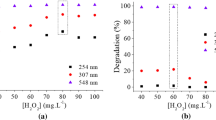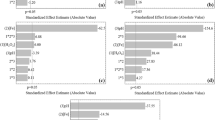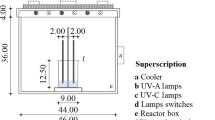Abstract
The decolorization of Reactive Blue 19 (RB19) from aqueous solutions using the Fenton oxidation process was researched. The effects of different operating parameters, e.g., H2O2, Fe(II), initial dye concentration, pH, and solution temperature, on the decolorization of RB19 were investigated. Increasing, the H2O2 concentration and temperature increased the rate of the decolorization; however, increasing initial RB19 concentration reduced the decolorization. Additionally, modeling of the decolorization obtained by the Fenton oxidation process was researched based on deep neural networks (DNN) architecture providing the best performance in terms of optimum hidden layers and neuron numbers in addition to ideal activation and optimization function pairs. The performances of the models were analyzed on the training, validation, and test data. According to the experimental results, the seven hidden layers DNN model with “relu” activation function and “RMSProp” optimization function provided the best performance with root mean square error (RMSE) of 3.39 and correlation coefficient (R2) of 0.99.










Similar content being viewed by others
References
Alalm, M. G., Tawfik, A., & Ookawara, S. (2015). Degradation of four pharmaceuticals by solar photo-Fenton process: kinetics and costs estimation. Journal of Environmental Chemical Engineering, 3(1), 46–51.
Alexander, D. L. J., Tropsha, A., & Winkler, D. A. (2015). Beware of R2: Simple, unambiguous assessment of the prediction accuracy of QSAR and QSPR models. Journal of Chemical Information and Modeling, 55(7), 1316–1322.
Alver, A., & Kazan, Z. (2020). Prediction of full-scale filtration plant performance using artificial neural networks based on principal component analysis. Separation and Purification Technology. https://doi.org/10.1016/j.seppur.2019.115868.
Azbar, N., Yonar, T., & Kestioglu, K. (2004). Comparison of various advanced oxidation processes and chemical treatment methods for COD and color removal from a polyester and acetate fiber dyeing effluent. Chemosphere, 55(1), 35–43.
Babuponnusami, A., & Muthukumar, K. (2014). A review on Fenton and improvements to the Fenton process for wastewater treatment. Journal of Environmental Chemical Engineering, 2(1), 557–572.
Bae, W., Won, H., Hwang, B., de Toledo, R. A., Chung, J., Kwon, K., et al. (2015). Characterization of refractory matters in dyeing wastewater during a full-scale Fenton process following pure-oxygen activated sludge treatment. Journal of Hazardous Materials, 287, 421–428.
Bagal, M. V., & Gogate, P. R. (2014). Wastewater treatment using hybrid treatment schemes based on cavitation and Fenton chemistry: a review. Ultrasonics Sonochemistry, 21(1), 1–14.
Baştürk, E., & Alver, A. (2019). Modeling azo dye removal by sono-Fenton processes using response surface methodology and artificial neural network approaches. Journal of Environmental Management. https://doi.org/10.1016/j.jenvman.2019.109300.
Bautista, P., Mohedano, A. F., Gilarranz, M. A., Casas, J. A., & Rodriguez, J. J. (2007). Application of Fenton oxidation to cosmetic wastewaters treatment. Journal of Hazardous Materials, 143(1–2), 128–134.
Bayhan, Y. K., & Degermenci, G. D. (2017). Investigation of kinetic and removal of organic matter from cosmetic wastewaters by Fenton process. Journal of the Faculty of Engineering and Architecture of Gazi University. https://doi.org/10.17341/gazimmfd.300609.
Behnajady, M. A., Modirshahla, N., & Ghanbary, F. (2007). A kinetic model for the decolorization of CI acid yellow 23 by Fenton process. Journal of Hazardous Materials, 148(1–2), 98–102.
Bhatti, A. A., Kamboh, M. A., Solangi, I. B., & Memon, S. (2013). Synthesis of calix [6] arene based XAD-4 material for the removal of reactive blue 19 from aqueous environments. Journal of Applied Polymer Science, 130(2), 776–785.
Chang, M. W., & Chern, J. M. (2010). Decolorization of peach red azo dye, HF6 by Fenton reaction: Initial rate analysis. Journal of the Taiwan Institute of Chemical Engineers, 41(2), 221–228.
Chavaco, L. C., Arcos, C. A., & Prato-Garcia, D. (2017). Decolorization of reactive dyes in solar pond reactors: perspectives and challenges for the textile industry. Journal of Environmental Management. https://doi.org/10.1016/j.jenvman.2017.04.077.
Daneshvar, N., Khataee, A. R., & Djafarzadeh, N. (2006). The use of artificial neural networks (ANN) for modeling of decolorization of textile dye solution containing CI basic yellow 28 by electrocoagulation process. Journal of Hazardous Materials, 137(3), 1788–1795.
Değermenci, G. D., Değermenci, N., Ayvaoğlu, V., Durmaz, E., Çakır, D., & Akan, E. (2019). Adsorption of reactive dyes on lignocellulosic waste; characterization, equilibrium, kinetic and thermodynamic studies. Journal of Cleaner Production, 225, 1220–1229.
Elmolla, E. S., Chaudhuri, M., & Eltoukhy, M. M. (2010). The use of artificial neural network (ANN) for modeling of COD removal from antibiotic aqueous solution by the Fenton process. Journal of Hazardous Materials, 179(1–3), 127–134.
Emami, F., Tehrani-Bagha, A. R., Gharanjig, K., & Menger, F. M. (2010). Kinetic study of the factors controlling Fenton-promoted destruction of a non-biodegradable dye. Desalination, 257(1–3), 124–128.
Fanchiang, J. M., & Tseng, D. H. (2009). Degradation of anthraquinone dye CI reactive blue 19 in aqueous solution by ozonation. Chemosphere, 77(2), 214–221.
Ghosh, P., Samanta, A. N., & Ray, S. (2010). COD reduction of petrochemical industry wastewater using Fenton’s oxidation. The Canadian Journal of Chemical Engineering, 88(6), 1021–1026.
Hayat, H., Mahmood, Q., Pervez, A., Bhatti, Z. A., & Baig, S. A. (2015). Comparative decolorization of dyes in textile wastewater using biological and chemical treatment. Separation and Purification Technology, 154, 149–153.
Hu, Q. H., Qiao, S. Z., Haghseresht, F., Wilson, M. A., & Lu, G. Q. (2006). Adsorption study for removal of basic red dye using bentonite. Industrial & Engineering Chemistry Research, 45(2), 733–738.
Kavitha, V., & Palanivelu, K. (2005). Destruction of cresols by Fenton oxidation process. Water Research, 39(13), 3062–3072.
Khan, J., Sayed, M., Ali, F., & Khan, H. M. (2018). Removal of acid yellow 17 dye by Fenton oxidation process. Zeitschrift für Physikalische Chemie, 232(4), 507–525.
Li, H., Li, Y., Xiang, L., Huang, Q., Qiu, J., Zhang, H., et al. (2015). Heterogeneous photo-Fenton decolorization of Orange II over Al-pillared Fe-smectite: response surface approach, degradation pathway, and toxicity evaluation. Journal of Hazardous Materials, 287, 32–41.
Lin, S. H., & Leu, H. G. (1999). Operating characteristics and kinetic studies of surfactant wastewater treatment by Fenton oxidation. Water Research, 33(7), 1735–1741.
Lin, S. H., & Lo, C. C. (1997). Fenton process for treatment of desizing wastewater. Water Research, 31(8), 2050–2056.
Lucas, M. S., & Peres, J. A. (2006). Decolorization of the azo dye reactive black 5 by Fenton and photo-Fenton oxidation. Dyes and Pigments, 71(3), 236–244.
Michael, I., Hapeshi, E., Michael, C., & Fatta-Kassinos, D. (2010). Solar Fenton and solar TiO2 catalytic treatment of ofloxacin in secondary treated effluents: evaluation of operational and kinetic parameters. Water Research, 44(18), 5450–5462.
Mirzaei, A., Chen, Z., Haghighat, F., & Yerushalmi, L. (2017). Removal of pharmaceuticals from water by homo/heterogonous Fenton-type processes–a review. Chemosphere, 174, 665–688.
Mousavi, S. A., Vasseghian, Y., & Bahadori, A. (2018). Evaluate the performance of Fenton process for the removal of methylene blue from aqueous solution: experimental, neural network modeling and optimization. Environmental Progress & Sustainable Energy. https://doi.org/10.1002/ep.13126.
Nidheesh, P. V., Zhou, M., & Oturan, M. A. (2018). An overview on the removal of synthetic dyes from water by electrochemical advanced oxidation processes. Chemosphere, 197, 210–227.
Özdemir, C., Tezcan, H., Sahinkaya, S., & Kalipci, E. (2010). Pretreatment of olive oil mill wastewater by two different applications of Fenton oxidation processes. CLEAN–Soil Air Water, 38(12), 1152–1158.
Radwan, M., Alalm, M. G., & Eletriby, H. (2018). Optimization and modeling of electro-Fenton process for treatment of phenolic wastewater using nickel and sacrificial stainless steel anodes. Journal of Water Process Engineering, 22, 155–162.
Ravì, D., Wong, C., Deligianni, F., Berthelot, M., Andreu-Perez, J., Lo, B., et al. (2016). Deep learning for health informatics. IEEE Journal of Biomedical and Health Informatics, 21(1), 4–21.
Şahinkaya, S. (2013). COD and color removal from synthetic textile wastewater by ultrasound assisted electro-Fenton oxidation process. Journal of Industrial and Engineering Chemistry, 19(2), 601–605.
Sanchis, S., Polo, A. M., Tobajas, M., Rodriguez, J. J., & Mohedano, A. F. (2014). Coupling Fenton and biological oxidation for the removal of nitrochlorinated herbicides from water. Water Research, 49, 197–206.
Shi, X., Tian, A., You, J., Yang, H., Wang, Y., & Xue, X. (2018). Degradation of organic dyes by a new heterogeneous Fenton reagent-Fe2GeS4 nanoparticle. Journal of Hazardous Materials, 353, 182–189.
Siddique, M., Farooq, R., & Price, G. J. (2014). Synergistic effects of combining ultrasound with the Fenton process in the degradation of reactive blue 19. Ultrasonics Sonochemistry, 21(3), 1206–1212.
Slokar, Y. M., & Le Marechal, A. M. (1998). Methods of decoloration of textile wastewaters. Dyes and Pigments, 37(4), 335–356.
Sun, J. H., Sun, S. P., Wang, G. L., & Qiao, L. P. (2007). Degradation of azo dye Amido black 10B in aqueous solution by Fenton oxidation process. Dyes and Pigments, 74(3), 647–652.
Sun, S. P., Li, C. J., Sun, J. H., Shi, S. H., Fan, M. H., & Zhou, Q. (2009). Decolorization of an azo dye Orange G in aqueous solution by Fenton oxidation process: effect of system parameters and kinetic study. Journal of Hazardous Materials, 161(2–3), 1052–1057.
Suteu, D., Bilba, D., Aflori, M., Doroftei, F., Lisa, G., Badeanu, M., et al. (2012). The seashell wastes as biosorbent for reactive dye removal from textile effluents. CLEAN–Soil Air Water, 40(2), 198–205.
Titouhi, H., & Belgaied, J. E. (2016). Heterogeneous Fenton oxidation of ofloxacin drug by iron alginate support. Environmental Technology, 37(16), 2003–2015.
Vilar, A., Eiroa, M., Kennes, C., & Veiga, M. C. (2013). Optimization of the landfill leachate treatment by the Fenton process. Water and Environment Journal, 27(1), 120–126.
Wang, J., Jiang, Y., Zhang, Z., Zhang, X., Ma, T., Zhang, G., et al. (2007). Investigation on the sonocatalytic degradation of acid red B in the presence of nanometer TiO2 catalysts and comparison of catalytic activities of anatase and rutile TiO2 powders. Ultrasonics Sonochemistry, 14(5), 545–551.
Willmott, C. J., & Matsuura, K. (2005). Advantages of the mean absolute error (MAE) over the root mean square error (RMSE) in assessing average model performance. Climate Research, 30(1), 79–82.
Xie, X., Zheng, X., Yu, C., Zhang, Q., Wang, Y., Cong, J., et al. (2019). Tea residue boosts dye decolorization and induces the evolution of bacterial community. Water Air & Soil Pollution. https://doi.org/10.1007/s11270-019-4307-6.
Zhang, H., Duan, L., & Zhang, D. (2006). Decolorization of methyl orange by ozonation in combination with ultrasonic irradiation. Journal of Hazardous Materials, 138(1), 53–59.
Author information
Authors and Affiliations
Corresponding author
Additional information
Publisher’s Note
Springer Nature remains neutral with regard to jurisdictional claims in published maps and institutional affiliations.
Rights and permissions
About this article
Cite this article
Değermenci, N., Akyol, K. Decolorization of the Reactive Blue 19 from Aqueous Solutions with the Fenton Oxidation Process and Modeling with Deep Neural Networks. Water Air Soil Pollut 231, 72 (2020). https://doi.org/10.1007/s11270-020-4402-8
Received:
Accepted:
Published:
DOI: https://doi.org/10.1007/s11270-020-4402-8




